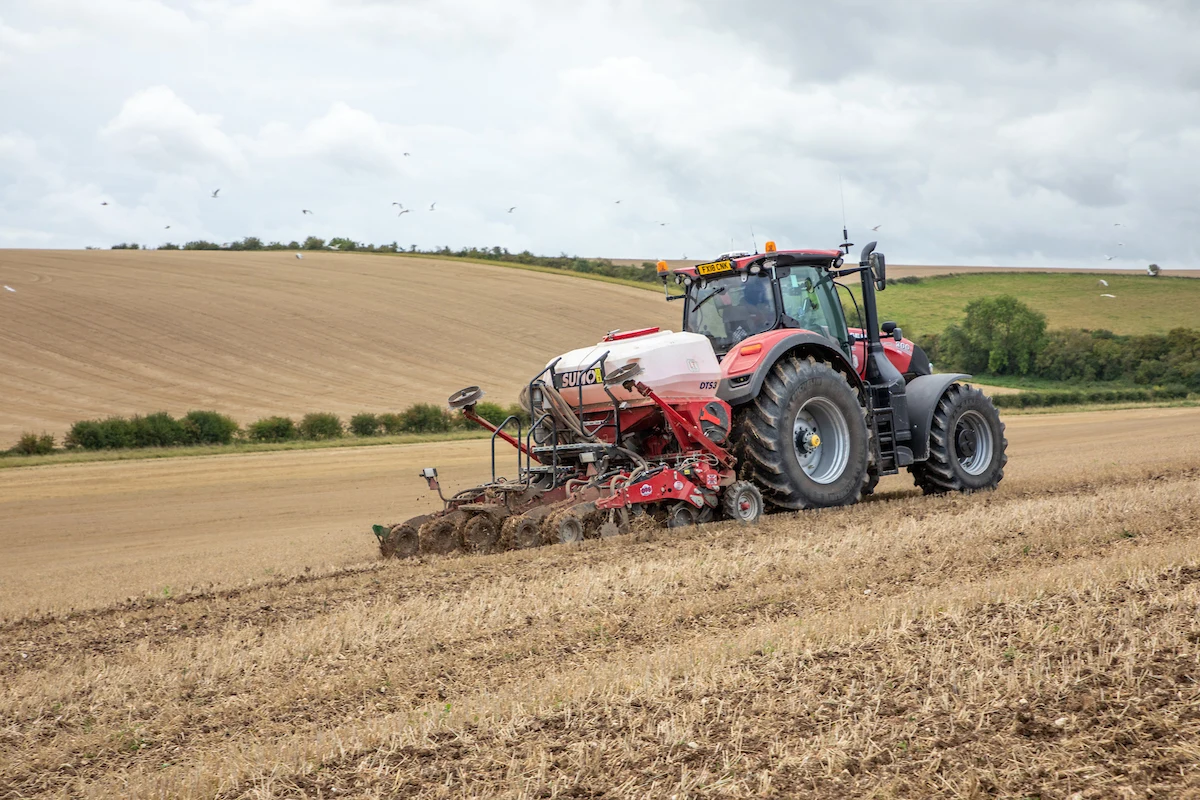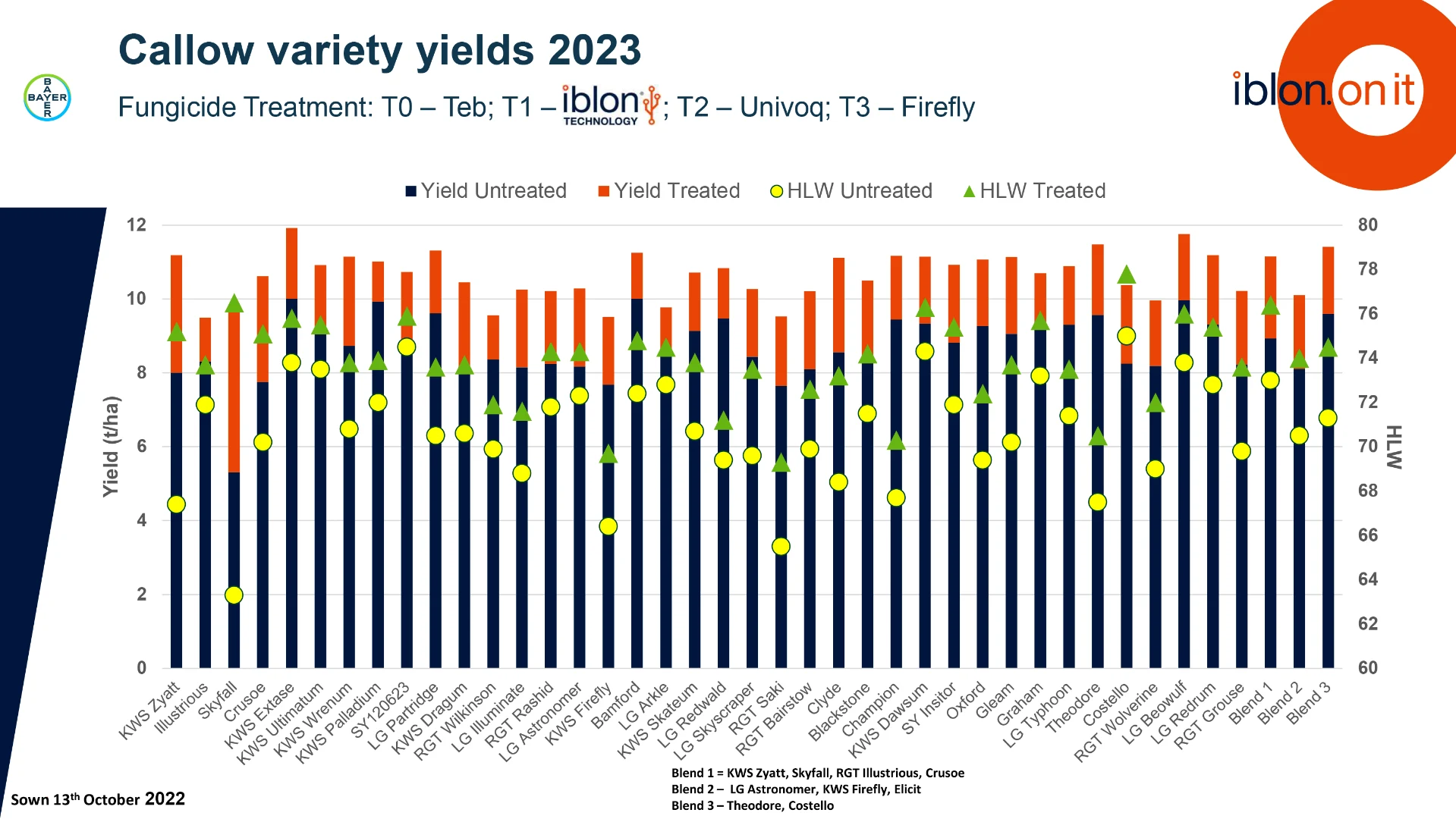Published on 29th August 2023
Local Insights
Six possible agronomy queries by western growers this September

Gareth Bubb talks through six areas of possible concern for growers in the west this September
Six possible agronomy queries by western growers this September
Crop Progress
Some better weather in the middle of August picked up the pace, but overall, it has been a tough harvest. Yields have been average, and more lodging than we’ve seen for several years. Specific weights in wheat have been variable and also struggled due to the poor weather during grain fill.
KWS Extase and candidate variety LG Beowulf were the highest yielding varieties in our trial (see chart) from Callow, Herefordshire – see point 7 below for my three main conclusions from the trial.
One observation is that growers who had a decision to make in the spring about some ropey oilseed rape crops, have generally been glad they didn’t rip them out as it recovered enough to probably yield more than anything they could have put in would have done.
We’ve also got some good trials data on pod shatter in oilseed rape varieties this year. Everybody expects varieties to have pod shatter resistance but we know, and this year’s trials show, that it’s definitely not the case. But it is an important trait to consider when choosing an oilseed rape variety.
Some oilseed rape has been planted, with some already up, there was still plenty to go in with 10 days still left in August.
Gareth’s agronomy tips for September
1. It’s not too late to drill oilseed rape
Oilseed rape planting in the west tends to be a bit later than other parts of the country, with wheat harvest being later on better soils. Where it hasn’t been drilled in August, it’s still perfectly possible to have a decent yielding crop from September plantings.
Oilseed rape is a valuable rotation crop, not only for potential gross margins but also for management purposes – for example, giving early entry to subsequent crops, although be mindful that it can increase slug populations and pressure in those crops. There aren’t a huge number of alternative break crop options either.
When drilling in September, choose a variety that will get away quickly. In more marginal conditions, like late sowing, the extra vigour from hybrids will start to be picked out.
How late you can still plant oilseed rape in September is down to the weather in October and November, but you will have more leeway with a hybrid variety.
Agronomically, later drilled crops will likely have less disease pressure, especially from light leaf spot. I don’t think you need to change seed rates, but later drilled crops could be more susceptible to pigeons because there will be more exposed soil, meaning landing sites, for longer.
We’re also trialling a new digital tool, MagicTrap to monitor pests, such as cabbage stem flea beetle remotely. Commercially available in Germany, the MagicTrap has a high-resolution camera that photos and evaluates the contents of the yellow trap at regular intervals, allowing crops to be monitored remotely via a smartphone app.
2. What about cover crops?
Cover crops will usually be more successful if planted in August, but it’s not necessarily too late to establish them in September. I would think carefully about what species are in your mix – I’d try to avoid spending loads on lots of species that might not establish in September, or at least expect some to fail.
3. Don’t forget about green bridges
Barley yellow dwarf virus was more prevalent last season perhaps as the impact of losing neonicotinoid seed treatments becomes more obvious. With more growers using no or lower tillage systems and the payment incentive to remove insecticides, the old concept of removing green bridges needs to be remembered.
I understand the desire to have something growing in the soil as much as possible, but it does provide habitat for aphids and other pests or diseases to carry over into the next crop. And while predators do increase, you will never have a more predators than prey, or at least there will be a lag which could be enough to transmit virus.
We’ve done some trials looking at the timing of taking out volunteers with Roundup (glyphosate), which have clearly shown that the optimum time is 10 days before drilling to reduce BYDV because you get less transfer to the new crop.
That might be a compromise for difficult grassweeds where closer to drilling is probably optimal, so it means thinking about the whole programme and thinking about priorities. For stewardship reasons to minimise resistance risk, you’re also trying to avoid using two consecutive applications of Roundup without some form of cultivation in between.
Have a plan for the whole programme and consider what the implications of each step might be.
4. Should you drill cereals in September?
While there’s no reason why you can’t drill wheat in September, but you have to bear in mind that the earlier you sow, the greater risk of BYDV, grassweeds and Septoria.
If you drill a Septoria susceptible variety in September, you might be facing a battle or a challenge in the spring that you can’t do much about simply because of what variety you chose and when it was drilled.
Herbicide, virus and fungicide decisions all start with variety and drilling date, so it requires more thought than just looking at the variety list and picking the highest yielding variety.
The last week of September historically is thought of as the ideal time to drill winter barley – yield is driven by big biomass and generally you get a bigger biomass from drilling early. Again though, drilling earlier will increase BYDV – winter barley and oats are the most susceptible crops – disease risk and grassweed burdens, which there are limited options to control.
The caveat to all this though is the weather. For the past few years October has been the wettest month, and if you leave drilling until October on good strong ground and get heavy rainfall you might not get anything into the ground.
So, it’s about weighing all this up – there is no right answer, but it’s important to understand that every positive decision or outcome can have a negative effect as well.
5. Weed control options for September drilled crops
If you do decide to drill cereals in September, the sensible approach remains choosing your cleanest fields for grassweeds first and leaving the dirtier ones until last.
I would also be looking to use multiple modes of action, with our starter for 10 being Liberator (flufenacet + diflufenican) + Proclus (aclonifen). Remember Proclus must be applied pre-emergence.
In wheat you can then add in other actives as needed, such as prosulfocarb, tri-allate or pendimethalin, either in addition to the pre-emergence or as follow-ups.
Where you have grassweeds I would apply a robust pre-emergence as soon as possible after drilling – ideally within 48 hours. Make sure seed is drilled to a good depth and understand the more actives you include especially on lighter land, and the more rainfall after application, the greater the risk of damaging the crop.
In winter barley, Liberator + Proclus is also an option, but the rate of Proclus is 1.0 L/ha compared with 1.4 L/ha in wheat. We also don’t back the addition of other residual herbicides at pre-emergence to that mix, although you could follow up with Alternator Met / Octavian Met (flufenacet + diflufenican + metribuzin) plus another residual such as pendimethalin.
6. Keep an eye on blight
Blight programmes will reach their conclusion in potatoes this month. There have been some reports of blight outbreaks, although it hasn’t been the worst year.
For the last sprays activity against tuber blight is important, which is where Infinito (propamocarb + fluopicolide) will be helpful with strong activity against both foliar and tuber blight.
7. What can we learn from Callow wheat variety trials this year?
I’ve drawn three main conclusions from the yield results from our Callow variety trial this season.
Yields are lower than the previous year
Farmers may be unhappy about this as they have spent more money on the crop and it’s probably worth less, but yield is ultimately determined by the weather and without the extra spend may have been even lower.
Specific weights are a lot lower than the previous year
They are determined by genetics and the patterns are there, but values are lower than normal which is probably attributed to the poor weather during grain fill.
Consistent yield increases across varieties
Although we may remember last season for being a particularly bad Septoria year, all varieties, with the exception of Skyfall which had more yellow rust than most, gave a similar response to fungicides; even the likes of Theodore and Champion.




